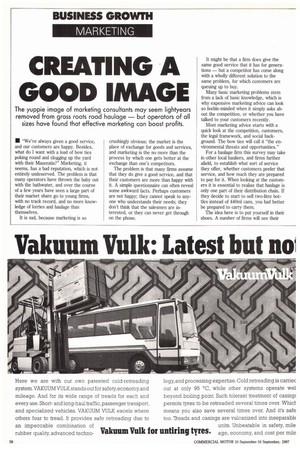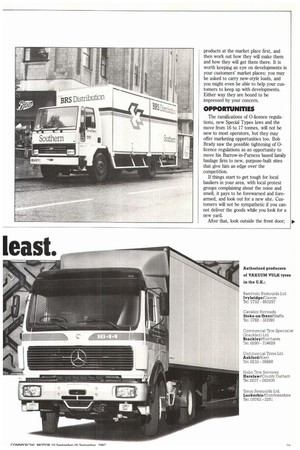CREATING A GOOD IMAGE
Page 60

Page 61

If you've noticed an error in this article please click here to report it so we can fix it.
• "We've always Oven a good service, and our customers are happy. Besides, what do I want with a load of bow ties poking round and clogging up the yard with their Maseratis?" Marketing, it seems, has a bad reputation, which is not entirely undeserved. The problem is that many operators have thrown the baby out with the bathwater, and over the course of a few years have seen a large part of their market share go to young firms, with no track record, and no more knowledge of lorries and haulage than themselves.
It is sad, because marketing is so crushingly obvious; the market is the place of exchange for goods and services, and marketing is the no more than the process by which one gets better at the exchange than one's competitors.
The problem is that many firms assume that they do give a good service, and that their customers are more than happy with it. A simple questionnaire can often reveal some awkward facts. Perhaps customers are not happy; they cannot speak to anyone who understands their needs; they don't think that the salesmen are interested, or they can never get through on the phone. It might be that a firm does give the same good service that it has for generations — but a competitor has come along with a wholly different solution to the same problem, for which customers are queuing up to buy.
Many basic marketing problems stem from a lack of basic knowledge, which is why expensive marketing advice can look so feeble-minded when it simply asks about the competition, or whether you have talked to your customers recently.
Most marketing advice starts with a quick look at the competition, customers, the legal framework, and social background. The bow ties will call it "the environmental threats and opportunities."
For a haulage firm this survey may take in other local hauliers, and firms further afield, to establish what sort of service they offer, whether customers prefer that service, and how much they are prepared to pay for it. When looking at the customers it is essential to realise that haulage is only one part of their distribution chain. If they decide to start to sell two-litre bottles instead of 440m1 cans, you had better be prepared to carry them.
The idea here is to put yourself in their shoes. A number of firms will see their products at the market place first, and then work out how they will make them and how they will get them there. It is worth keeping an eye on developments in your customers' market places; you may be asked to carry new-style loads, and you might even be able to help your customers to keep up with developments. Either way they are bound to be impressed by your concern.
The ramifications of 0-licence regulations, new Special Types laws and the move from 16 to 17 tonnes, will not be new to most operators, but they may offer marketing opportunities too. Bob Brady saw the possible tightening of 0licence regulations as an opportunity to move his Barrow-in-Furness based family haulage firm to new, purpose-built sites that give him an edge over the competition.
If things start to get tough for local hauliers in your area, with local protest groups complaining about the noise and smell, it pays to be forewarned and forearmed, and look out for a new site. Customers will not be sympathetic if you cannot deliver the goods while you look for a new yard.
After that, look outside the front door;












































































































